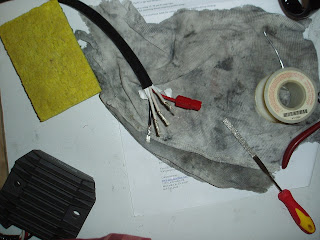Next step is the wiring harness side of the connector. This is the nerve-wracking part. It's one thing to wreck a $100 regulator/rectifier, another thing to wreck a wiring harness. Extreme caution was warranted.
The first step was to remove the burned connector. I labeled the white wires even though that's not supposed to be necessary. Was then unable to slide the metal connectors out of the plastic piece so I had to cut it off, leaving slightly less wire to work with. Then stripped the ends off the 5 wires.
Next, slide on the metal connectors, crimp and solder into place. As with the regulator side, the red and black wires were too thick to fit entirely into the connector. If I were to do this again I'd get the next size larger connector (30 amp) for these connections.
After jamming as much wire as I could into the connectors I crimped and soldered them on, filing off the extra solder as before. The soldering requires extreme precision to avoid melting any other nearby hoses, wires, or electrical connections. A lot of holding my breath.
With the plastic housings slid over the metal connectors I was able to start joining the 2 sides of the connection.
Per recommendation in Eskador's procedure I zip-tied the connectors together. I expected them to snap into place but they just sort of slid and stayed in place by friction, which seemed kind of haphazard. They did not want to stay joined by themselves which might seem to indicate a different connector. So, zip ties.
 |
| Final connector bundle, all zip ties in place |
So, this is pretty good. Remains to be seen how long those connectors and my crappy soldering will hold up. So for the next few weeks I'll be checking the battery voltage as above every weekend.
















